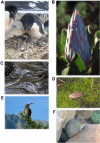Hemispheric asymmetries in biodiversity--a serious matter for ecology
- PMID: 15547645
- PMCID: PMC526784
- DOI: 10.1371/journal.pbio.0020406
Hemispheric asymmetries in biodiversity--a serious matter for ecology
Abstract
Although the poles are less diverse than the tropics, this decline shows substantial asymmetries between the hemispheres, suggesting that responses to environmental change may differ substantially in the north and the south.
Figures






References
-
- Addo-Bediako A, Chown SL, Gaston KJ. Metabolic cold adaptation in insects: A large-scale perspective. Funct Ecol. 2002;16:332–338.
-
- Blackburn TM, Gaston KJ. Spatial patterns in the species richness of birds in the New World. Ecography. 1996;19:369–376.
-
- Bonan G. Ecological climatology: Concepts and applications. Cambridge: Cambridge University Press; 2002. 690 pp.
-
- Brown JH, Lomolino MV. Biogeography, 2nd ed. Sunderland (Massachusetts): Sinauer Associates; 1998. 691 pp.

